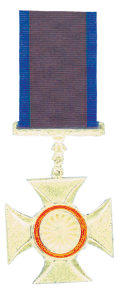
The South African Police (SAP) was the national police force and law enforcement agency in South Africa from 1913 to 1994; it was the de facto police force in the territory of South West Africa (Namibia) from 1939 to 1981. After South Africa's transition to majority rule in 1994, the SAP was reorganised into the South African Police Service (SAPS).
South African orders, decorations and medals are those military and civilian orders, decorations and medals issued by the Government of South Africa. The following is a (non-exhaustive) list of these:
The South African honours system consists of orders, decorations, and medals which are conferred on citizens, and others, to recognise a range of services and achievements. The system has developed since 1894.
An overview of South African intelligence service decorations and medals, which form part of the South African honours system.
An overview of South African prisons service decorations and medals, which form part of the South African honours system.

The Pro Merito Decoration, post-nominal letters PMD, is a military decoration for merit which was instituted by the Republic of South Africa on 1 July 1975. It was awarded to other ranks of the South African Defence Force for outstanding service of the highest order and utmost devotion to duty.
The South African Police Star for Distinguished Leadership was a high-ranking decoration, that existed between 1979 and 1986. It was reserved for senior police officers, and was awarded only twice. Recipients were entitled to use the post-nominal letters SED, standing for Stella Excellentis Ductus, the Latin form of the name.
The South African Police Star for Distinguished Service was a high-ranking decoration that existed between 1963 and 1986. Originally a dual-purpose decoration for bravery and for outstanding service, it was converted into an award for senior officers only in 1979. Recipients were entitled to use the post-nominal letters SOO, standing for Stella Officii Optimi, the Latin form of the name.
The South African Police Cross for Bravery was a high-ranking decoration, that existed between 1963 and 2004. It initially had only one class, but it was expanded to three classes in 1988.
The South African Police Silver Cross for Gallantry was a decoration that existed between 1985 and 1989.
The South African Police Star for Outstanding Service was a decoration that existed between 1979 and 2004. Recipients are entitled to the post-nominal letters SOE, standing for Stella Officii Egregii, the Latin form of the name.
The Republic of Namibia has an honours system comprising orders, medals, military decorations, and police decorations. Legislation also provides for the establishment of decorations and medals for the intelligence service, the prisons service, and the fire services.

The Pro Virtute Decoration, post-nominal letters PVD, is a military decoration for bravery which was instituted by the Republic of South Africa in 1987. It was awarded to officers of the South African Defence Force for distinguished conduct and exceptional leadership during combat operations in the field.

The Gallantry Cross, Gold was instituted by the President of the Republic of Venda in 1985, for award to all ranks for extreme courage or supreme bravery or valour beyond the normal call of duty.

The Gallantry Cross, Silver, post-nominal letters GCS, was instituted by the President of the Republic of Venda in 1985, for award to all ranks for courage or bravery or valour beyond the normal call of duty.

The Distinguished Service Medal, Gold was instituted by the President of the Republic of Venda in 1985, for award to all ranks for exceptionally meritorious service and particular devotion to duty.

The Long Service Medal, Silver was instituted by the President of the Republic of Venda in 1985, for award to all ranks for twenty years exemplary service.

The Decoration for Merit in Gold, post-nominal letters DMG, was instituted by the President of the Republic of South Africa in April 1996. It was awarded to veteran cadres of uMkhonto we Sizwe, the military wing of the African National Congress, who had distinguished themselves during the "struggle" by outstanding service and utmost devotion to duty.

The Bravery Star in Silver, post-nominal letters BSS, was instituted by the President of the Republic of South Africa in April 1996. It was awarded to veteran cadres of the Azanian People's Liberation Army, the military wing of the Pan Africanist Congress, who had distinguished themselves during "the struggle" by performing acts of bravery.

The Star for Conspicuous Leadership, post-nominal letters SCL, was instituted by the President of the Republic of South Africa in April 1996. It was awarded to veteran cadres of the Azanian People's Liberation Army, the military wing of the Pan Africanist Congress, for distinguished conduct and exceptional combat leadership during the "struggle".

 South African Police Star for Distinguished Leadership (SED)
South African Police Star for Distinguished Leadership (SED) South African Police Star for Distinguished Service (SOO) [lower-alpha 1]
South African Police Star for Distinguished Service (SOO) [lower-alpha 1]  South African Police Cross for Bravery (PCF) [lower-alpha 2]
South African Police Cross for Bravery (PCF) [lower-alpha 2]  South African Police Cross for Bravery (Gold) (PCFG)
South African Police Cross for Bravery (Gold) (PCFG) South African Police Silver Cross for Gallantry (Silver) (SCG)
South African Police Silver Cross for Gallantry (Silver) (SCG) South African Police Cross for Bravery (Silver) (PCFS)
South African Police Cross for Bravery (Silver) (PCFS) South African Police Cross for Bravery (PCF) [lower-alpha 3]
South African Police Cross for Bravery (PCF) [lower-alpha 3]  South African Police Star for Distinguished Service (SOO) [lower-alpha 4]
South African Police Star for Distinguished Service (SOO) [lower-alpha 4]  South African Police Star for Outstanding Service (SOE)
South African Police Star for Outstanding Service (SOE)  South African Police Star for Merit
South African Police Star for Merit  South African Police Star for Faithful Service
South African Police Star for Faithful Service  South African Police Medal for Faithful Service
South African Police Medal for Faithful Service 












